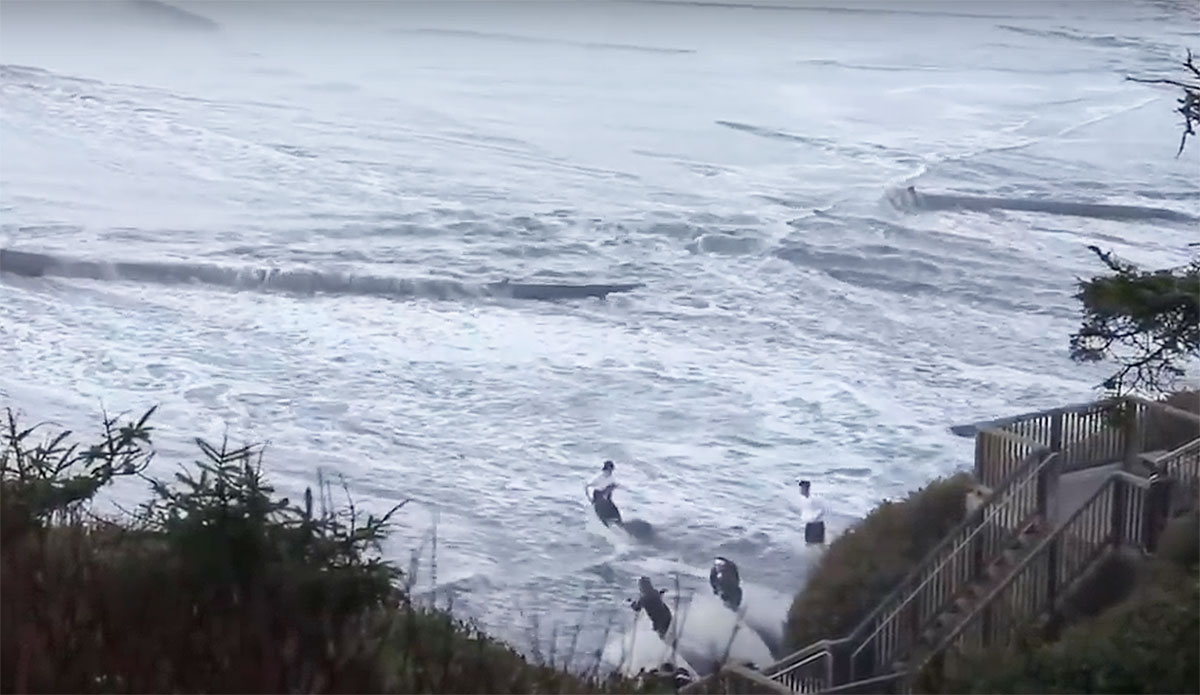
A sneaker wave catches beachgoers unaware at Rockaway Beach, Oregon. Image: NWS/Screenshot
Sneaker waves are weird, aren’t they? If you’ve spent much time at a beach — which, if you’re here, you probably have — you’ve seen them. They’re also called “wave runup events,” and they’re basically what they sound like: a wave or set of waves that surges farther up the beach than anyone thought. They’re often stronger than normal waves, and can be bad for the unsuspecting spectator. Researchers looking into how, exactly, they occur, appear to have figured it out.
The researchers, who are from Oregon State University, used a particular sneaker wave event in their study. On January 16, 2016, beaches in Washington, Oregon, and Northern California were inundated by a bunch of waves that hurt a handful of people and swamped a car. These waves struck beaches from Humboldt Bay, California, to Pacific Beach, Washington, and happened over a five-hour span. After looking into those waves, the researchers found that far-off storms and a particular set of near-shore conditions were the cause. Now, that’s not all that surprising — that’s basically how all waves are formed — but it is expected to be helpful in predicting these kind of things in the future. Sneaker waves aren’t the same thing as rogue waves, just F.Y.I.
“The finding is an important step in understanding the causes of sneaker waves and developing a system for predicting such waves, which could improve warning systems and help reduce deaths and injuries, said Tuba Özkan-Haller, interim dean of OSU’s College of Earth, Ocean, and Atmospheric Sciences and a co-author of the study.
According to ScienceDaily, a publication that features discoveries in science, health, the environment, and technology, runup events kill an average to two people each year.
Elements of sneaker waves are slightly predictable already, but the new research might help make them even more so.
“There are some things that are predictable about sneaker waves — we know they are more likely to occur in winter months,” Özkan-Haller explained, “and that they are likely to occur in parts of the world where the continental shelf is narrow, such as the Pacific Northwest.”
Currently, the The National Weather Service uses those elements to issue sneaker wave warnings, but they’re generally pretty vague. The hope is that this new information will allow the NWS to clarify the whens and the wheres in the future.
“The more we learn, the closer we get to our ultimate goal, which would be to develop a warning system that is specific, accurate and localized,” Özkan-Haller said.
Researchers used the January 16 sneaker wave event for a few reasons. First, there were several of them within a relatively short amount of time, and second because many of them were recorded and posted to YouTube, giving them important visual information.
“The videos showed important general characteristics of the extreme runup events on this day — in particular that they were roughly five minutes from beginning to end,” said Chuan Li, the lead author of the study. “This information helped us identify their signals from tide gauges and also helped narrow down possible causes.”
Pairing those videos and old data showing the wave height readings and wind speeds at the time of the sneaker waves, the team was able to pinpoint the likely cause. They found an interesting relationship between two kinds of waves: the ones surfers ride on are called “surface gravity waves” but beneath them are longer waves called “infragravity” waves. They are fed by the energy of the surface gravity waves.
When one of those massive storms off Alaska or in the South Pacific kicks things up a notch, they increase the period of the swell event. That, as you know, gives a swell event more time to get organized, and it will arrive with more power and shape than a swell event with a shorter period. Those longer periods, however, also make the underlying infragravity waves longer and stronger.
“The longer the wave is, the less likely it is to break,” Özkan-Haller said. “Instead, it sloshes up, like the water would if you’re getting into a bathtub.”
Much like a tsunami, those longer infragravity waves are more likely to run farther up the beach, but not all of them will turn into sneaker waves. Near-shore weather and bathymetry also plays a role.
“If these long waves are forming out in the ocean, but there is also a local storm, the wave field is jumbled, and sneaker waves won’t occur,” Özkan-Haller said. “When the wind is calm, the local weather is mild — a beautiful day on the beach — sneaker waves are more likely.”

